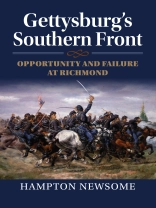On June 14, 1863, US Major General John Adams Dix received the following directive from General-in-Chief Henry Halleck: “All your available force should be concentrated to threaten Richmond, by seizing and destroying their railroad bridges over the South and North Anna Rivers, and do them all the damage possible.” With General Robert E. Lee and the Army of Northern Virginia marching toward Gettysburg and only a limited Confederate force guarding Richmond, Halleck sensed a rare o...
Tabella dei contenuti
List of Maps
Introduction
Part One: An Opportunity in Virginia
1. Lee Heads North
2. John Dix and the Department of Virginia
3. The Union Raid on A...
Circa l’autore
Hampton Newsome is the author of Richmond Must Fall: The Richmond-Petersburg Campaign, October 1864 and The Fight for the Old North State: The Civil War in North Caro...












